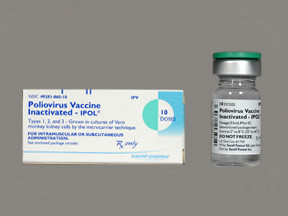POLIOVIRUS VACCINE - INJECTION
PHONETIC PRONUNCIATION: (POE-lee-oh)
COMMON BRAND NAME(S): Ipol
GENERIC NAME(S): poliomyelitis vaccine, killed
Uses
USES: This vaccine is used to prevent a certain virus infection (polio). Polio is a virus that affects mainly young children. It is usually spread by person-to-person contact. It can also be spread by eating/drinking contaminated food or water. Most people who get infected with polio have mild or no symptoms. However, some infections can be very serious and can cause inability to move (paralysis) in part of the body, such as the arms, legs, or breathing muscles. There is no cure for polio infection, but it can be prevented by vaccination. This vaccine works by increasing the body's natural defense (immunity) against the polio virus. Polio vaccine is usually given to infants and children as part of routine immunization. It may also be given to adults who haven't been immunized or who may be at increased risk for polio infection, for example by travel to countries where polio is common. Vaccines may not fully protect everyone who receives them.
How to use POLIOVIRUS VACCINE - INJECTION
HOW TO USE: Read all vaccine information available from your health care professional before receiving the vaccine. If you have any questions, ask your health care professional. This vaccine is given by a health care professional. It is usually injected into a thigh muscle. It may also be injected into the upper arm muscle or under the skin. This medication should not be injected into a vein. Vaccines are usually given in a series of doses to provide the best protection. Closely follow the vaccination schedule provided by your health care professional. Keep all scheduled medical appointments. It may be helpful to mark a calendar as a reminder. There are various combinations of vaccines available. Based on your age, vaccination history, and previous reaction to vaccines, your health care professional will decide which vaccines are best for you. Discuss the risks and benefits of vaccination with your health care professional. This vaccine is usually given at the same time as other vaccines.
Side Effects
Precautions
Interactions
Overdose
Reviews
Disclaimer
IMPORTANT: HOW TO USE THIS INFORMATION: This is a summary and does NOT have all possible information about this product. This information does not assure that this product is safe, effective, or appropriate for you. This information is not individual medical advice and does not substitute for the advice of your health care professional. Always ask your health care professional for complete information about this product and your specific health needs.


No Reviews Yet